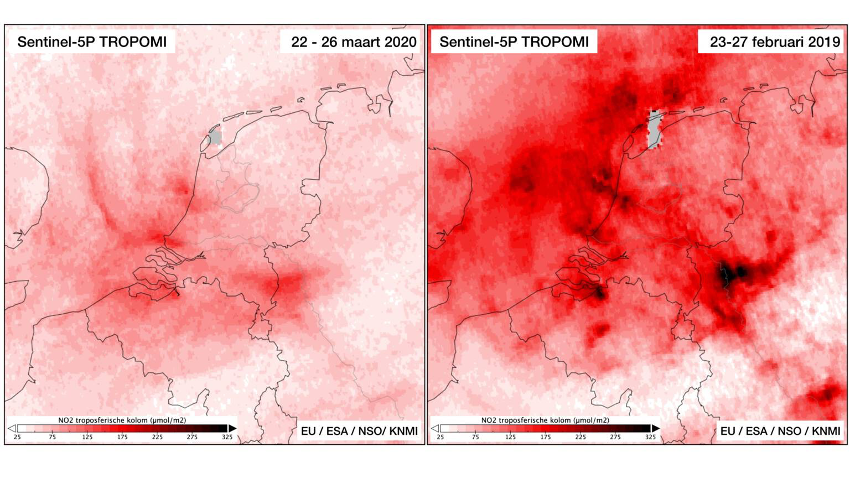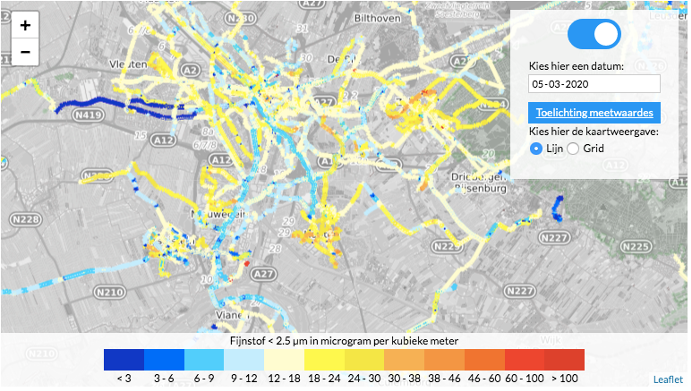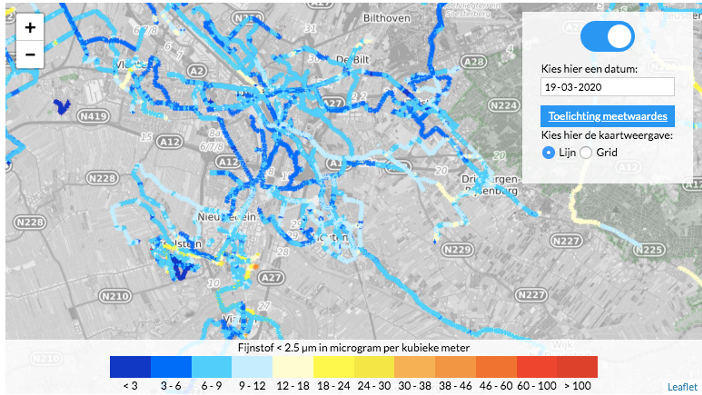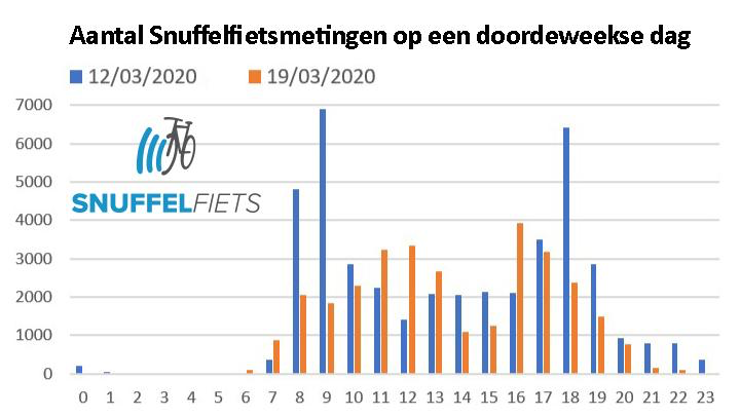The effects of corona measures on air quality and mobility
It has only been two and a half weeks since Prime Minister Rutte asked us not to shake hands, and since last week the future is looking very uncertain. Everyone is looking for their own way to work from home as much as possible. It’s extraordinary to see how quickly Mobycon has switched to a digital way of working and how our advisors, both internal and external, can be easily reached digitally. Although most of the messages we hear each day are heavy, we are also seeing some points of light. Just like Mobycon, the data collection continues. Various sources already show some effects in just a short period of COVID-19 measures.
Only 7% of Public Transport trips compared to 2 weeks ago
Figures from the itinerary app City Mapper show that there has been much less travel globally than two weeks ago. Travel data for similar days in early 2020 has been compared to data from the past few days. In Milan and Barcelona, there are currently the least travellers compared to a “normal” day, with less than 2% of trips taking place. In Amsterdam, the number of trips is also decreasing rapidly–5% of the “daily” public transport travellers. Of course, as public transport advisors this is not exactly the best news, but what bright spots can we find in this?
Reduction of nitrogen emissions, improvement of air quality (Wuhan and Belgium)
The reduction in the number of cars on the road and aircraft in the airspace is causing a significant reduction in nitrogen emissions and improvements in air quality. Previous measures from other countries have already shown positive effects. In China, for example, the amount of nitrogen dioxide in the air has decreased by an average of 35% since the end of January. In some cities this increased to more than 50 percent. In Belgium, the air quality is at a level between an ordinary and car-free Sunday, and a large decrease can be seen when people started working from home. All parameters from our southern neighbours therefore indicate that the air quality in terms of nitrogen dioxide and particulate matter is good to very good. In the space of a week, nitrogen dioxide levels in Brussels dropped from 89 to 32 micrograms, a reduction of no less than 66 percent. This past Saturday it reached 17 micrograms!
What’s the situation in the Netherlands?
This past weekend, the KNMI released details about the air quality in the Netherlands. Satellite images from the KNMI show an enormous reduction in air pollution when compared with a week, with similar weather conditions in February last year. An estimate of the reduction is still relatively uncertain and ranges from 20 to 60%. In order to arrive at a more accurate estimate, the KNMI will analyse even more ground measurements.

When we look at mobility, we are also seeing changes taking place. In the Netherlands, 38% fewer kilometres were driven in a week (between 13 and 20 March) and traffic jams decreased by 99%. Data from the Dutch Displacement Panel show that in the late afternoon on Thursday 19 March the figures were very different when compared to a regular Thursday. Around 16:00, 67% more people cycled, 57% more walked, 71% less used the public transport and 30% less travelled by car. Open NDW-data shows that, for example, on an regular working day during rush hour, the A1 between Hilversum and Amsterdam sees an average of 1455 cars. By way of comparison, during the second week of March the average was 841, a decrease of about 42%. The OV-fiets also saw a decline in usage, seeing about one quarter the trips from a normal day, as could be easily seen by the availability of bikes at busy stations like Utrecht Jaarbeursplein.
Seeing improvements with the “sniffer” bike.
Mobycon and the B-ITS program have been involved in setting up the “sniffer” bike program. The Snuffelfiets is a collaboration between the province of Utrecht, Civity, SODAQ and the RIVM, in which more than 500 cyclists have a sniff-sensor on their bicycle that calculates the particulate matter on the bicycle route. In addition to particulate matter, air quality also depends on nitrogen and weather conditions. The statutory particulate matter standard for PM2.5 is an annual average concentration of 25 µg/m3. The World Health Organisation (WHO) recommends a maximum annual average concentration of 10 µg/m3. When we put Thursday 5 March and Thursday 19 March side by side, the bikes measure a definite difference. As can be seen in the figures below, the fine dust emission around Utrecht on 5 March averaged between 9 and 30 µg/m3, while on 19 March it is between 0 and 12 µg/m3. The measures also have a different effect on the Sunffelfiets data. Since the COVID-19 measures started, the times at which people start cycling differ much more than on a regular day. People now cycle more around noon and around four o’clock.



My advice: when you really need a breath of fresh air, get on your bike.
An improvement in air quality is very positive, but we also have to think about our own health in these times. The advice of Amsterdam mayor Halsema was: “for those who can: take the bike, that’s the healthiest and best option”. Many Dutch people seem to be following that advice, and not just individuals’ health in benefiting: bicycle manufacturer VanMoof has seen sales of e-bikes increase by almost 50 percent since February compared to the same period last year.
According to the German virologist Michael Barczok the risk of infection during cycling is almost zero percent. It is also easy to keep the 1.5 metres distance on a bicycle and cycling contributes to a healthy functioning of your lungs. Cycling is a great way to stay fit and healthy now, to build up resistance and to empty your head in hard times. That’s why I would like to give you the advice: when the walls come towards you and you miss the fresh outside air, seek it out and enjoy a nice bike ride.
This contribution was provided by Sean Poot, a Junior Advisor with our Dutch team. For more information about his work, visit our Dutch site or reach out to him via email.

